Integrating Network Pharmacology and Molecular Docking Approaches to Decipher the Multi-Target Pharmacological Mechanism of Abrus precatorius L. Acting on Diabetes
Abstract
:1. Introduction
2. Results
2.1. Screening of Active Compounds and Targets
2.2. Compounds—Target Network Construction
2.3. PPI Network Construction
2.4. GO and KEGG Analysis
2.5. Molecular Docking
2.6. ADMET Profiling
3. Discussion
4. Materials and Methods
4.1. Collection and Screening of Active Compounds
4.2. Screening for Potential Target Genes for A. precatorius Active Constituents against T2DM
4.3. Pathway and Functional Enrichment Analysis
4.4. Network Construction
4.5. Protein–Protein Network Construction and Molecular Docking
4.6. ADMET Profiling
5. Conclusions
Supplementary Materials
Author Contributions
Funding
Institutional Review Board Statement
Informed Consent Statement
Data Availability Statement
Acknowledgments
Conflicts of Interest
References
- Tuei, V.C.; Maiyoh, G.K.; Ha, C.E. Type 2 diabetes mellitus and obesity in sub-Saharan Africa. Diabetes/Metab. Res. Rev. 2010, 26, 433–445. [Google Scholar] [CrossRef] [PubMed]
- Forouhi, N.G.; Wareham, N.J. The EPIC-InterAct Study: A study of the interplay between genetic and lifestyle behavioral factors on the risk of type 2 diabetes in European populations. Curr. Nutr. Rep. 2014, 3, 355–363. [Google Scholar] [CrossRef] [PubMed] [Green Version]
- Vermeire, E.I.; Wens, J.; Van Royen, P.; Biot, Y.; Hearnshaw, H.; Lindenmeyer, A. Interventions for improving adherence to treatment recommendations in people with type 2 diabetes mellitus. Cochrane Database Syst. Rev. 2005, 2, CD003638. [Google Scholar] [CrossRef] [PubMed]
- Whiting, D.R.; Guariguata, L.; Weil, C.; Shaw, J. IDF diabetes atlas: Global estimates of the prevalence of diabetes for 2011 and 2030. Diabetes Res. Clin. Pract. 2011, 94, 311–321. [Google Scholar] [CrossRef]
- Olokoba, A.B.; Obateru, O.A.; Olokoba, L.B. Type 2 diabetes mellitus: A review of current trends. Oman Med. J. 2012, 27, 269. [Google Scholar] [CrossRef]
- Mukherjee, A.; Morales-Scheihing, D.; Butler, P.C.; Soto, C. Type 2 diabetes as a protein misfolding disease. Trends Mol. Med. 2015, 21, 439–449. [Google Scholar] [CrossRef] [Green Version]
- Zhao, W.-Q.; Townsend, M. Insulin resistance and amyloidogenesis as common molecular foundation for type 2 diabetes and Alzheimer’s disease. Biochim. Biophys. Acta (BBA)-Mol. Basis Dis. 2009, 1792, 482–496. [Google Scholar] [CrossRef] [Green Version]
- Garaniya, N.; Bapodra, A. Ethno botanical and Phytophrmacological potential of Abrus precatorius L.: A review. Asian Pac. J. Trop. Biomed. 2014, 4, S27–S34. [Google Scholar] [CrossRef] [Green Version]
- Ghosal, S.; Dutta, S. Alkaloids of Abrus precatorius. Phytochemistry 1971, 10, 195–198. [Google Scholar] [CrossRef]
- Sujit, K.; Tanusri, B.; Sourav, P.; Jadupati, M.; Amites, G.; Amitava, G. Pharmacognostical studies and chromatographic evaluation of the different extracts of Abrus precatorius Linn. Int. J. Pharm. Res. Dev. 2012, 4, 225–233. [Google Scholar]
- Chang, H.-M.; Chiang, T.-C.; Mak, T.C. Isolation and structure elucidation of abruslactone a: A new oleanene-type triterpene from the roots and vines of Abrus precatorius L. J. Chem. Soc. Chem. Commun. 1982, 20, 1197–1198. [Google Scholar] [CrossRef]
- Dong, Y.; Hao, L.; Fang, K.; Han, X.-X.; Yu, H.; Zhang, J.-J.; Cai, L.-J.; Fan, T.; Zhang, W.-D.; Pang, K. A network pharmacology perspective for deciphering potential mechanisms of action of Solanum nigrum L. in bladder cancer. BMC Complement. Med. Ther. 2021, 21, 45. [Google Scholar] [CrossRef] [PubMed]
- Chandran, U.; Mehendale, N.; Patil, S.; Chaguturu, R.; Patwardhan, B. Network pharmacology. In Innovative Approaches in Drug Discovery; Elsevier: Amsterdam, The Netherlands, 2017; pp. 127–164. [Google Scholar]
- Li, H.; Zhao, L.; Zhang, B.; Jiang, Y.; Wang, X.; Guo, Y.; Liu, H.; Li, S.; Tong, X. A network pharmacology approach to determine active compounds and action mechanisms of ge-gen-qin-lian decoction for treatment of type 2 diabetes. Evid.-Based Complement. Altern. Med. 2014, 2014, 495840. [Google Scholar] [CrossRef] [PubMed] [Green Version]
- Shao, L.; Zhang, B. Traditional Chinese medicine network pharmacology: Theory, methodology and application. Chin. J. Nat. Med. 2013, 11, 110–120. [Google Scholar]
- Chow, S.C. Bioavailability and bioequivalence in drug development. Wiley Interdiscip. Rev. Comput. Stat. 2014, 6, 304–312. [Google Scholar] [CrossRef] [Green Version]
- Daina, A.; Michielin, O.; Zoete, V. SwissADME: A free web tool to evaluate pharmacokinetics, drug-likeness and medicinal chemistry friendliness of small molecules. Sci. Rep. 2017, 7, 42717. [Google Scholar] [CrossRef] [Green Version]
- Jia, Y.; Zou, J.; Wang, Y.; Zhang, X.; Shi, Y.; Liang, Y.; Guo, D.; Yang, M. Mechanism of allergic rhinitis treated by Centipeda minima from different geographic areas. Pharm. Biol. 2021, 59, 606–618. [Google Scholar] [CrossRef]
- Hsieh, T.-C.; Lin, C.-Y.; Bennett, D.J.; Wu, E.; Wu, J.M. Biochemical and cellular evidence demonstrating AKT-1 as a binding partner for resveratrol targeting protein NQO2. PLoS ONE 2014, 9, e101070. [Google Scholar] [CrossRef] [Green Version]
- Xie, Z.-T.; Liu, B.; Xiong, Y.-y.; Yang, Y.-F.; Wu, H.-Z. Study of components and mechanism of Juechuang against platelet aggregation based on network pharmacology. Nat. Prod. Commun. 2020, 15. [Google Scholar] [CrossRef]
- Surampudi, P.N.; John-Kalarickal, J.; Fonseca, V.A. Emerging concepts in the pathophysiology of type 2 diabetes mellitus. Mt. Sinai J. Med. J. Transl. Pers. Med. J. Transl. Pers. Med. 2009, 76, 216–226. [Google Scholar] [CrossRef]
- Beran, D.; Ewen, M.; Laing, R. Constraints and challenges in access to insulin: A global perspective. Lancet Diabetes Endocrinol. 2016, 4, 275–285. [Google Scholar] [CrossRef]
- Tsang, M.-W. The management of type 2 diabetic patients with hypoglycaemic agents. Int. Sch. Res. Not. 2012, 2012, 478120. [Google Scholar] [CrossRef] [Green Version]
- Aslam, S.; Ahmad, S.; Noor, F.; Ashfaq, U.A.; Shahid, F.; Rehman, A.; Tahir ul Qamar, M.; Alatawi, E.A.; Alshabrmi, F.M.; Allemailem, K.S. Designing a Multi-Epitope Vaccine against Chlamydia trachomatis by Employing Integrated Core Proteomics, Immuno-Informatics and In Silico Approaches. Biology 2021, 10, 997. [Google Scholar] [CrossRef] [PubMed]
- Rehman, A.; Ashfaq, U.A.; Shahid, F.; Noor, F.; Aslam, S. The Screening of phytochemicals against NS5 Polymerase to treat Zika Virus infection: Integrated computational based approach. Comb. Chem. High Throughput Screen. 2022, 25, 738–751. [Google Scholar] [CrossRef] [PubMed]
- Noor, F.; Noor, A.; Ishaq, A.R.; Farzeen, I.; Saleem, M.H.; Ghaffar, K.; Aslam, M.F.; Aslam, S.; Chen, J.-T. Recent Advances in Diagnostic and Therapeutic Approaches for Breast Cancer: A Comprehensive Review. Curr. Pharm. Des. 2021, 27, 2344–2365. [Google Scholar] [CrossRef] [PubMed]
- Noor, F.; Saleem, M.H.; Chen, J.-T.; Javed, M.R.; Al-Megrin, W.A.; Aslam, S. Integrative bioinformatics approaches to map key biological markers and therapeutic drugs in Extramammary Paget’s disease of the scrotum. PLoS ONE 2021, 16, e0254678. [Google Scholar]
- Mobin, L.; Saeed, S.A.; Ali, R.; Saeed, S.G.; Ahmed, R. Antibacterial and antifungal activities of the polyphenolic fractions isolated from the seed coat of Abrus precatorius and Caesalpinia crista. Nat. Prod. Res. 2018, 32, 2835–2839. [Google Scholar] [CrossRef] [PubMed]
- Taur, D.; Patil, R. Mast cell stabilizing and antiallergic activity of Abrus precatorius in the management of asthma. Asian Pac. J. Trop. Med. 2011, 4, 46–49. [Google Scholar] [CrossRef] [Green Version]
- Jouad, H.; Haloui, M.; Rhiouani, H.; El Hilaly, J.; Eddouks, M. Ethnobotanical survey of medicinal plants used for the treatment of diabetes, cardiac and renal diseases in the North centre region of Morocco (Fez–Boulemane). J. Ethnopharmacol. 2001, 77, 175–182. [Google Scholar] [CrossRef]
- Abo, K.; Fred-Jaiyesimi, A.; Jaiyesimi, A. Ethnobotanical studies of medicinal plants used in the management of diabetes mellitus in South Western Nigeria. J. Ethnopharmacol. 2008, 115, 67–71. [Google Scholar] [CrossRef]
- Sofi, M.S.; Sateesh, M.; Bashir, M.; Ganie, M.A.; Nabi, S. Chemopreventive and anti-breast cancer activity of compounds isolated from leaves of Abrus precatorius L. 3 Biotech 2018, 8, 371. [Google Scholar] [CrossRef]
- Boye, A.; Acheampong, D.O.; Gyamerah, E.O.; Asiamah, E.A.; Addo, J.K.; Mensah, D.A.; Brah, A.S.; Ayiku, P.J. Glucose lowering and pancreato-protective effects of Abrus precatorius (L.) leaf extract in normoglycemic and STZ/Nicotinamide–Induced diabetic rats. J. Ethnopharmacol. 2020, 258, 112918. [Google Scholar] [CrossRef]
- Demchuk, M.; Ivankova, O.; Klunnyk, M.; Matiyashchuk, I.; Sych, N.; Sinelnyk, A.; Novytska, D.; Sorochynska, K. Efficacy of fetal stem cells use in complex treatment of patients with insulin-resistant type 2 diabetes mellitus. J. Stem Cell Res. Ther. 2016, 6, 6. [Google Scholar] [CrossRef] [Green Version]
- Zhang, T.; Huang, J.; Yi, Y.; Zhang, X.; Loor, J.J.; Cao, Y.; Shi, H.; Luo, J. Akt serine/threonine kinase 1 regulates de novo fatty acid synthesis through the mammalian target of rapamycin/sterol regulatory element binding protein 1 axis in dairy goat mammary epithelial cells. J. Agric. Food Chem. 2018, 66, 1197–1205. [Google Scholar] [CrossRef] [PubMed]
- Li, S. Network pharmacology evaluation method guidance-draft. World J. Tradit. Chin. Med. 2021, 7, 146. [Google Scholar] [CrossRef]
- Mohanraj, K.; Karthikeyan, B.S.; Vivek-Ananth, R.; Chand, R.; Aparna, S.; Mangalapandi, P.; Samal, A. IMPPAT: A curated database of Indian medicinal plants, phytochemistry and therapeutics. Sci. Rep. 2018, 8, 4329. [Google Scholar] [CrossRef] [Green Version]
- Ru, J.; Li, P.; Wang, J.; Zhou, W.; Li, B.; Huang, C.; Li, P.; Guo, Z.; Tao, W.; Yang, Y. TCMSP: A database of systems pharmacology for drug discovery from herbal medicines. J. Cheminform. 2014, 6, 13. [Google Scholar] [CrossRef] [Green Version]
- Nakamura, K.; Shimura, N.; Otabe, Y.; Hirai-Morita, A.; Nakamura, Y.; Ono, N.; Ul-Amin, M.A.; Kanaya, S. KNApSAcK-3D: A three-dimensional structure database of plant metabolites. Plant Cell Physiol. 2013, 54, e4. [Google Scholar] [CrossRef]
- Gfeller, D.; Grosdidier, A.; Wirth, M.; Daina, A.; Michielin, O.; Zoete, V. SwissTargetPrediction: A web server for target prediction of bioactive small molecules. Nucleic Acids Res. 2014, 42, W32–W38. [Google Scholar] [CrossRef]
- Szklarczyk, D.; Santos, A.; Von Mering, C.; Jensen, L.J.; Bork, P.; Kuhn, M. STITCH 5: Augmenting protein–chemical interaction networks with tissue and affinity data. Nucleic Acids Res. 2016, 44, D380–D384. [Google Scholar] [CrossRef]
- Safran, M.; Dalah, I.; Alexander, J.; Rosen, N.; Iny Stein, T.; Shmoish, M.; Nativ, N.; Bahir, I.; Doniger, T.; Krug, H. GeneCards Version 3: The human gene integrator. Database 2010, 2010, baq020. [Google Scholar] [CrossRef]
- Boutet, E.; Lieberherr, D.; Tognolli, M.; Schneider, M.; Bairoch, A. Uniprotkb/swiss-prot. In Plant Bioinformatics; Springer: Berlin/Heidelberg, Germany, 2007; pp. 89–112. [Google Scholar]
- Sherman, B.T.; Tan, Q.; Collins, J.R.; Alvord, W.G.; Roayaei, J.; Stephens, R.; Baseler, M.W.; Lane, H.C.; Lempicki, R.A. The DAVID Gene Functional Classification Tool: A novel biological module-centric algorithm to functionally analyze large gene lists. Genome Biol. 2007, 8, R183. [Google Scholar]
- Noor, F.; Saleem, M.H.; Aslam, M.F.; Ahmad, A.; Aslam, S. Construction of miRNA-mRNA network for the identification of key biological markers and their associated pathways in IgA nephropathy by employing the integrated bioinformatics analysis. Saudi J. Biol. Sci. 2021, 28, 4938–4945. [Google Scholar] [CrossRef] [PubMed]
- Sufyan, M.; Ashfaq, U.A.; Ahmad, S.; Noor, F.; Saleem, M.H.; Aslam, M.F.; El-Serehy, H.A.; Aslam, S. Identifying key genes and screening therapeutic agents associated with diabetes mellitus and HCV-related hepatocellular carcinoma by bioinformatics analysis. Saudi J. Biol. Sci. 2021, 28, 5518–5525. [Google Scholar] [CrossRef] [PubMed]
- Noor, F.; Ashfaq, U.A.; Javed, M.R.; Saleem, M.H.; Ahmad, A.; Aslam, M.F.; Aslam, S. Comprehensive computational analysis reveals human respiratory syncytial virus encoded microRNA and host specific target genes associated with antiviral immune responses and protein binding. J. King Saud Univ.-Sci. 2021, 33, 101562. [Google Scholar] [CrossRef]
- Mering, C.v.; Huynen, M.; Jaeggi, D.; Schmidt, S.; Bork, P.; Snel, B. STRING: A database of predicted functional associations between proteins. Nucleic Acids Res. 2003, 31, 258–261. [Google Scholar] [CrossRef]
- Berman, H.M.; Westbrook, J.; Feng, Z.; Gilliland, G.; Bhat, T.N.; Weissig, H.; Shindyalov, I.N.; Bourne, P.E. The protein data bank. Nucleic Acids Res. 2000, 28, 235–242. [Google Scholar] [CrossRef] [Green Version]
- Pettersen, E.F.; Goddard, T.D.; Huang, C.C.; Couch, G.S.; Greenblatt, D.M.; Meng, E.C.; Ferrin, T.E. UCSF Chimera—A visualization system for exploratory research and analysis. J. Comput. Chem. 2004, 25, 1605–1612. [Google Scholar] [CrossRef] [Green Version]
- Vilar, S.; Cozza, G.; Moro, S. Medicinal chemistry and the molecular operating environment (MOE): Application of QSAR and molecular docking to drug discovery. Curr. Top. Med. Chem. 2008, 8, 1555–1572. [Google Scholar] [CrossRef]
- Dallakyan, S.; Olson, A.J. Small-molecule library screening by docking with PyRx. In Chemical Biology; Springer: Berlin/Heidelberg, Germany, 2015; pp. 243–250. [Google Scholar]
- Goddard, T.D.; Huang, C.C.; Meng, E.C.; Pettersen, E.F.; Couch, G.S.; Morris, J.H.; Ferrin, T.E. UCSF ChimeraX: Meeting modern challenges in visualization and analysis. Protein Sci. 2018, 27, 14–25. [Google Scholar] [CrossRef]
- Discovery Studio. Accelrys [2.1]San Diego, CA, USA. 2008. Available online: https://discover.3ds.com/discovery-studio-visualizer (accessed on 30 November 2021).
- Roy, S.; Kumar, A.; Baig, M.H.; Masařík, M.; Provazník, I. Virtual screening, ADMET profiling, molecular docking and dynamics approaches to search for potent selective natural molecules based inhibitors against metallothionein-III to study Alzheimer’s disease. Methods 2015, 83, 105–110. [Google Scholar] [CrossRef] [PubMed]
- Boušová, I.; Skálová, L. Inhibition and induction of glutathione S-transferases by flavonoids: Possible pharmacological and toxicological consequences. Drug Metab. Rev. 2012, 44, 267–286. [Google Scholar] [CrossRef] [PubMed]
- Rehman, A.; Wang, X.; Ahmad, S.; Shahid, F.; Aslam, S.; Ashfaq, U.A.; Alrumaihi, F.; Qasim, M.; Hashem, A.; Al-Hazzani, A.A. In Silico Core Proteomics and Molecular Docking Approaches for the Identification of Novel Inhibitors against Streptococcus pyogenes. Int. J. Environ. Res. Public Health 2021, 18, 11355. [Google Scholar] [CrossRef] [PubMed]
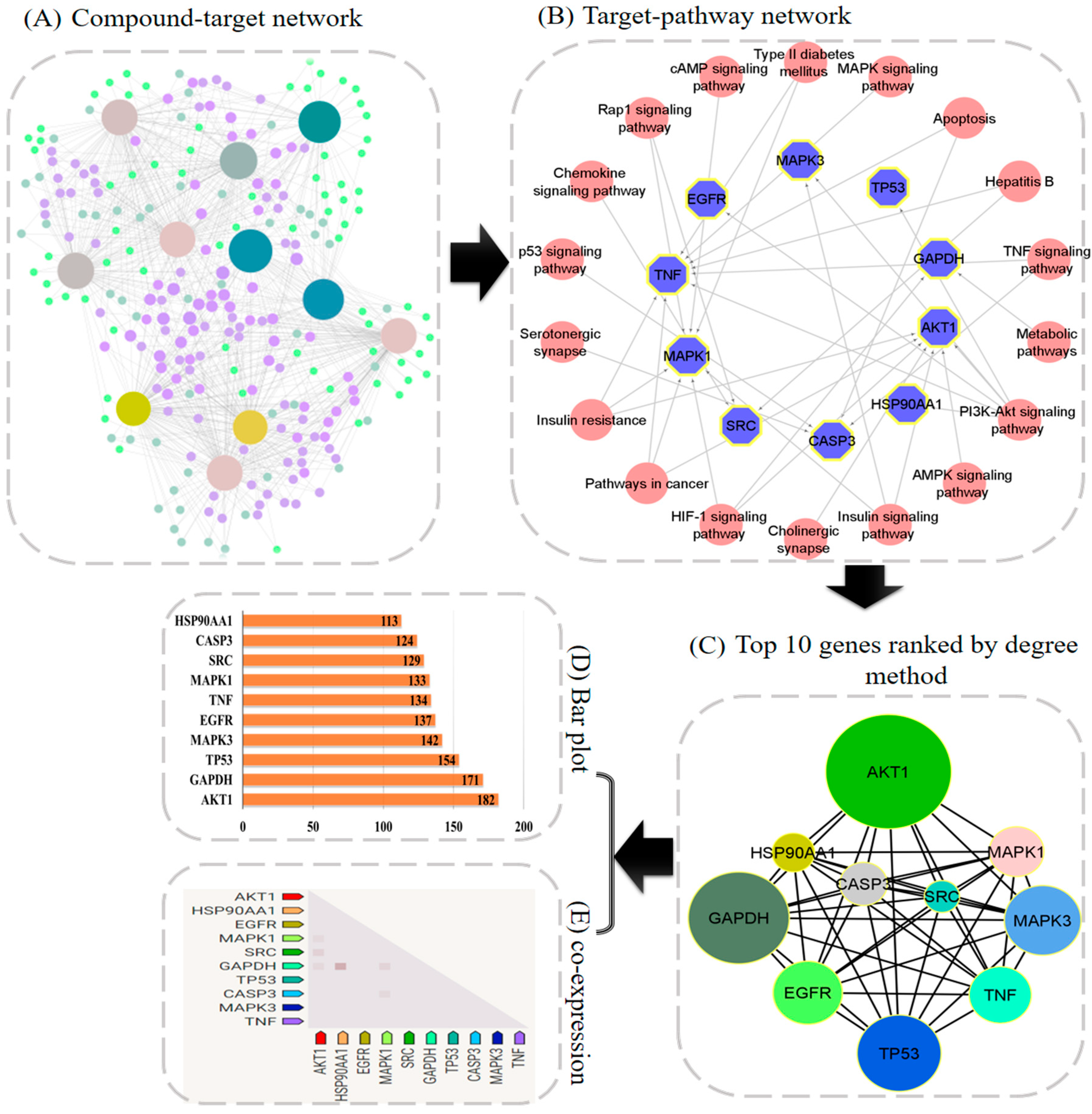
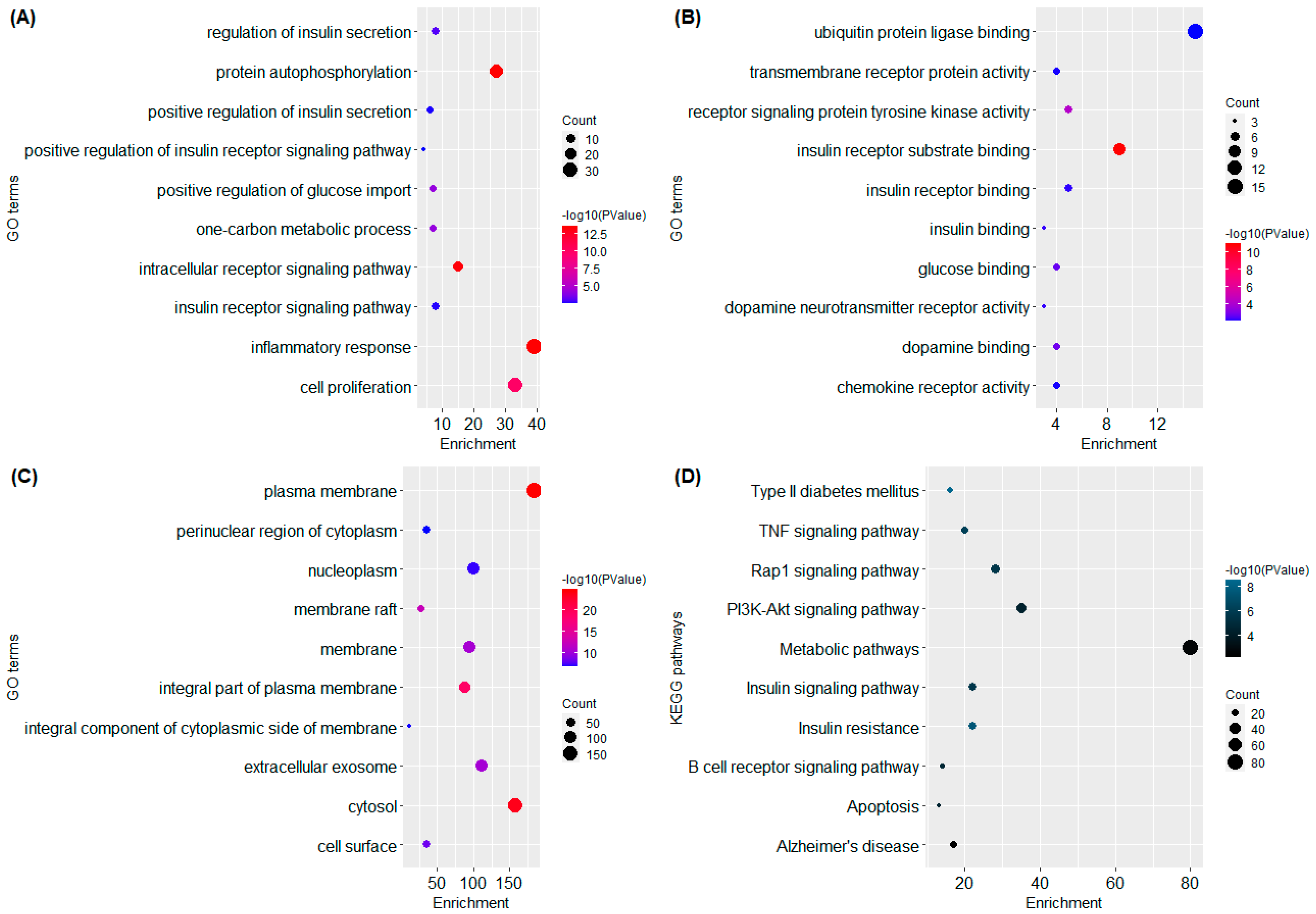

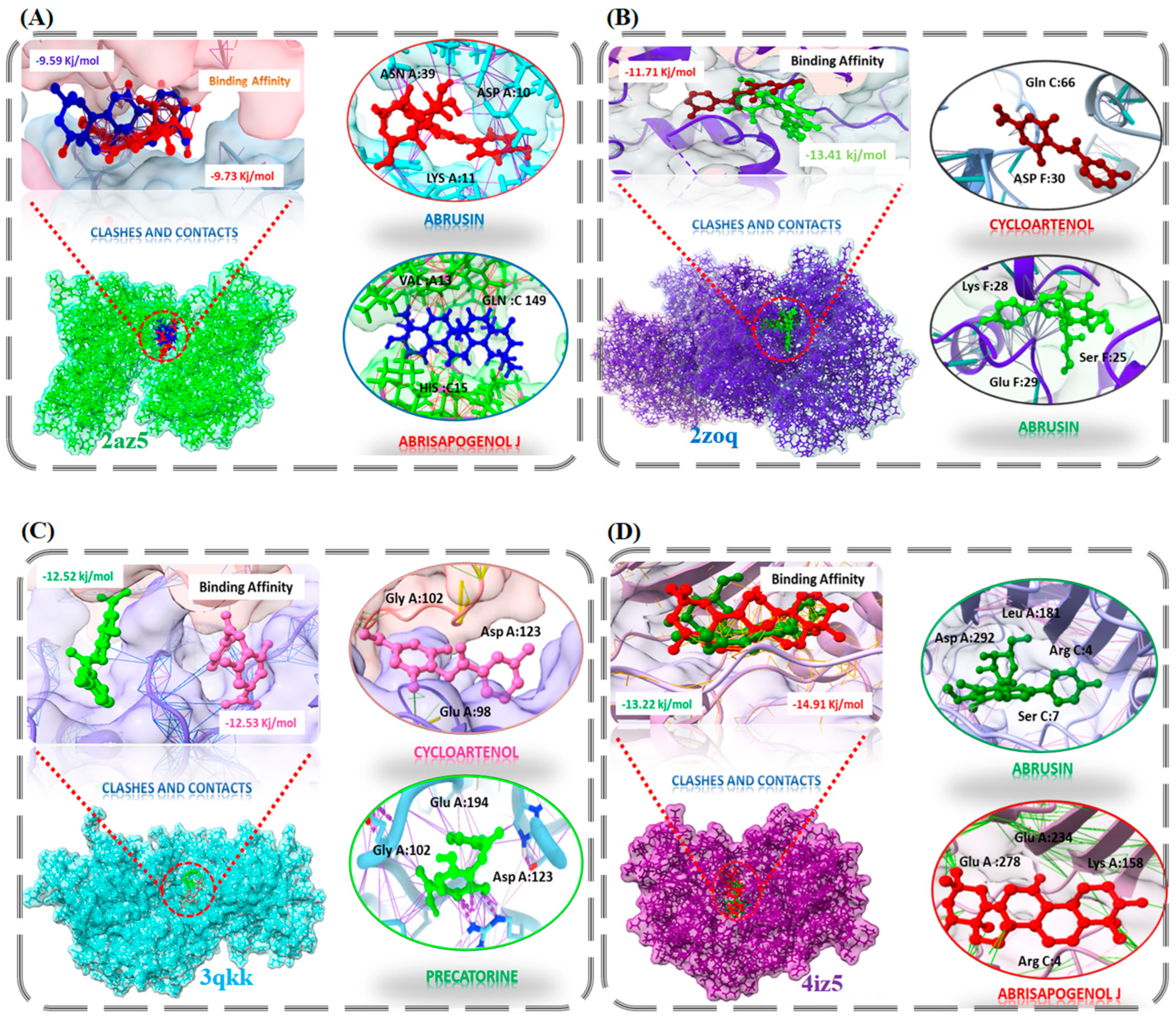
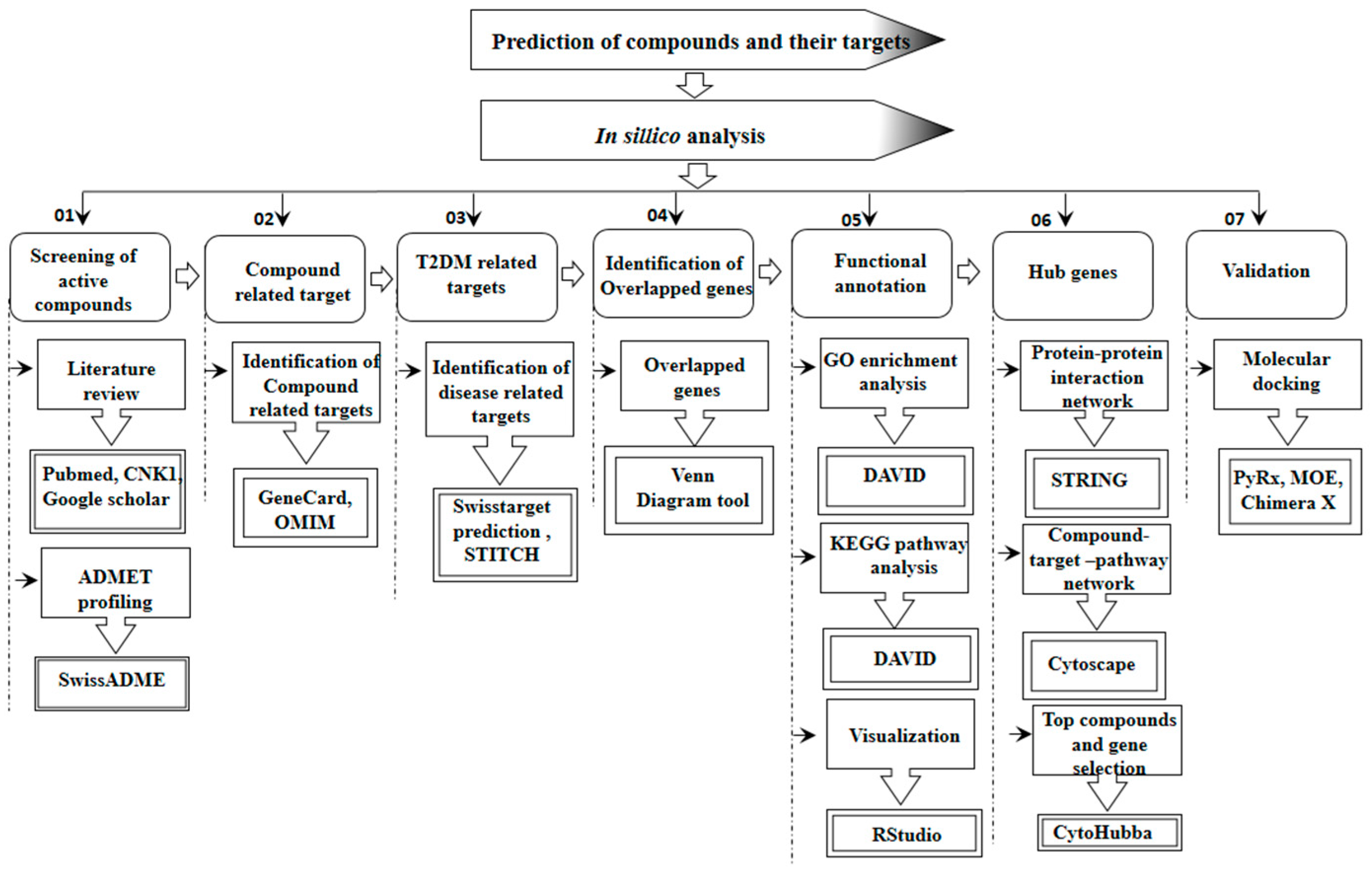
| Molecule Name | Molecular Weight (MW) | Drug Likeness (DL) | Bioavailability (F30%) | Structure | PubChem ID |
|---|---|---|---|---|---|
| Abrisapogenol J | 456.78 | 0.74 | 0.82 | 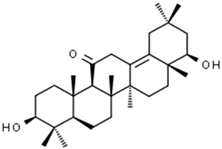 | 21594179 |
| Precatorine | 289.26 | 0.19 | 0.976 | 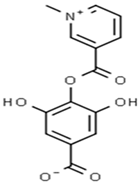 | 54704420 |
| Sophoradiol | 442.8 | 0.76 | 0.745 |  | 9846221 |
| Abrectorin | 314.31 | 0.31 | 0.978 | 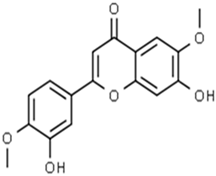 | 44257585 |
| Isoorientin | 448.41 | 0.76 | 1 | 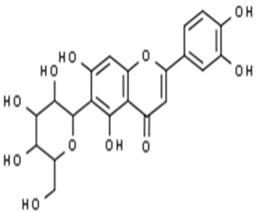 | 114776 |
| Cholanoic acid | 360.64 | 0.59 | 0.919 | 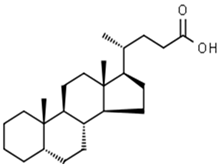 | 92803 |
| Cycloartenol | 426.8 | 0.78 | 0.972 |  | 92110 |
| Amyrin | 426.8 | 0.76 | 0.877 | 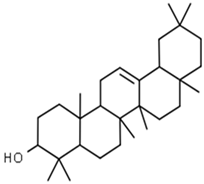 | 73145 |
| luteolin | 286.25 | 0.25 | 1 |  | 5280445 |
| Skrofulein | 314.31 | 0.3 | 0.632 | 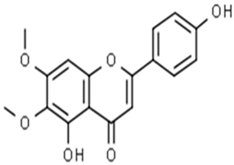 | 188323 |
| Abrusin | 476.47 | 0.78 | 0.905 | 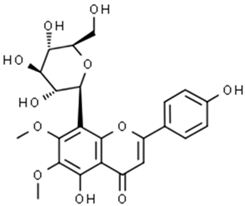 | 44258417 |
| Molecule Name | Class | Degree |
|---|---|---|
| Abrectorin | Flavonoids | 58 |
| Abrusin | Flavonoids | 45 |
| isoorientin | Flavonoids | 15 |
| Skrofulein | Flavonoids | 5 |
| Luteolin | Flavonoids | 4 |
| Abrisapogenol J | Triterpenoids | 94 |
| Cholanoic acid | Triterpenoids | 40 |
| Sophoradiol | Triterpenoids | 36 |
| Amyrin | Triterpenoids | 7 |
| Precatorine | Alkaloids | 78 |
| Cycloartenol | Steroids | 16 |
| Gene Name | Compounds | Score | Pathways |
|---|---|---|---|
| AKT1 | Abrectorin/isoorientin/Luteolin | 182 | AMPK signaling pathway, insulin resistance, PI3K-Akt signaling pathway, insulin signaling pathway |
| GAPDH | Abrusin | 171 | Metabolic pathways |
| TP53 | Cholanoic acid | 154 | PI3K-Akt signaling pathway |
| MAPK3 | Abrisapogenol J/Cycloartenol/Amyrin | 142 | PI3K-Akt signaling pathway, insulin signaling pathway |
| EGFR | Abrectorin/isoorientin/Luteolin | 137 | PI3K-Akt signaling pathway |
| TNFalpha | Isoorientin | 134 | Type II diabetes mellitus, insulin resistance |
| MAPK1 | Precatorine/Cholanoic acid | 133 | Type II diabetes mellitus, insulin resistance, insulin signaling pathway |
| SRC | Precatorine/sophoradiol | 129 | Rap1 signaling pathway |
| CASP3 | Precatorine | 124 | p53 signaling pathway |
| HSP90AA1 | Abrusin | 113 | PI3K-Akt signaling pathway |
| Target Proteins (PDB ID) | Compounds | Binding Affinity (kcal/mol) | RMSD | Interacting Residues |
|---|---|---|---|---|
| 2az5 | Abrisapogenol J | −9.7335 | 1.45 | HIS C: 15, LEU A: 36, VAL C: 17, ALA A: 38, LYS A: 11, ASP A: 10, ASN A: 39, ILE A: 155, TYR C: 151 |
| Abrusin | −9.5991 | 2.02 | HIS C: 15, LEU A: 36, VAL A: 13, LEU C: 36, ASP A: 100, GLN C: 150 | |
| 2zoq | Cycloartenol | −12.529 | 1.32 | GLY A: 102, ASP A: 123, LYS A: 181, ARG A: 104, HIS B: 195 |
| Precatorine | −12.527 | 1.32 | GLY A: 102, ASP A: 123, LYS A: 181, ARG A: 104, HIS B: 195 | |
| 3qkk | Abrisapogenol J | −13.22 | 0.84 | LEU A: 295, LEU A: 181,PHE A: 161, LYS A: 158, PHE A: 442, VAL A: 164, GLU A: 278, GLU A: 234, ARG C: 4 |
| Abrusin | −14.91 | 1.93 | LEU A: 181,LYS A: 179, ASP A: 292, THR A: 291, SER C: 7, LYS A: 276, ARG C: 4 | |
| 4iz5 | Abrusin | −13.41 | 1.32 | SER F: 70, SER F: 25, ALA F: 26, GLY C: 182, LYS F: 28, GLU F: 29, THR C: 181 |
| Cycloartenol | −11.716 | 1.92 | GLN C: 66, ASP F: 30 |
| Target Protein | Control Drug | PubChem ID | Binding Energy | RMSD |
|---|---|---|---|---|
| TNFalpha | Thalidomide | 5426 | −6.9 | 1.3 |
| MAPK3 | Minocycline | 54675783 | −6.7 | 1.9 |
| AKT1 | Resveratrol | 445154 | −5.9 | 1.8 |
| MAPK1 | Ulixertinib | 11719003 | −6.2 | 3.48 |
| Compounds | Abrisapogenol J | Abrusin | Precatorine | Cycloartenol |
|---|---|---|---|---|
| GI absorption | Low | Low | High | High |
| BBB permeant | No | No | No | No |
| P-gp substrate | No | No | No | No |
| CYP1A2 inhibitor | No | No | No | No |
| CYP2C19 inhibitor | No | No | No | No |
| CYP2C9 inhibitor | No | No | No | No |
| CYP2D6 inhibitor | No | No | No | No |
| Toxicity | ||||
| Reverse Mutation Assay AMES Test | Non-Toxic | Non-Toxic | Non-Toxic | Non-Toxic |
| Carcinogens | No | No | No | No |
| Cytotoxicity | Non-Cytotoxic | Non-Cytotoxic | Non-Cytotoxic | Non-Cytotoxic |
| Mutagenicity | No | No | No | No |
Publisher’s Note: MDPI stays neutral with regard to jurisdictional claims in published maps and institutional affiliations. |
© 2022 by the authors. Licensee MDPI, Basel, Switzerland. This article is an open access article distributed under the terms and conditions of the Creative Commons Attribution (CC BY) license (https://creativecommons.org/licenses/by/4.0/).
Share and Cite
Noor, F.; Rehman, A.; Ashfaq, U.A.; Saleem, M.H.; Okla, M.K.; Al-Hashimi, A.; AbdElgawad, H.; Aslam, S. Integrating Network Pharmacology and Molecular Docking Approaches to Decipher the Multi-Target Pharmacological Mechanism of Abrus precatorius L. Acting on Diabetes. Pharmaceuticals 2022, 15, 414. https://doi.org/10.3390/ph15040414
Noor F, Rehman A, Ashfaq UA, Saleem MH, Okla MK, Al-Hashimi A, AbdElgawad H, Aslam S. Integrating Network Pharmacology and Molecular Docking Approaches to Decipher the Multi-Target Pharmacological Mechanism of Abrus precatorius L. Acting on Diabetes. Pharmaceuticals. 2022; 15(4):414. https://doi.org/10.3390/ph15040414
Chicago/Turabian StyleNoor, Fatima, Abdur Rehman, Usman Ali Ashfaq, Muhammad Hamzah Saleem, Mohammad K. Okla, Abdulrahman Al-Hashimi, Hamada AbdElgawad, and Sidra Aslam. 2022. "Integrating Network Pharmacology and Molecular Docking Approaches to Decipher the Multi-Target Pharmacological Mechanism of Abrus precatorius L. Acting on Diabetes" Pharmaceuticals 15, no. 4: 414. https://doi.org/10.3390/ph15040414
APA StyleNoor, F., Rehman, A., Ashfaq, U. A., Saleem, M. H., Okla, M. K., Al-Hashimi, A., AbdElgawad, H., & Aslam, S. (2022). Integrating Network Pharmacology and Molecular Docking Approaches to Decipher the Multi-Target Pharmacological Mechanism of Abrus precatorius L. Acting on Diabetes. Pharmaceuticals, 15(4), 414. https://doi.org/10.3390/ph15040414








